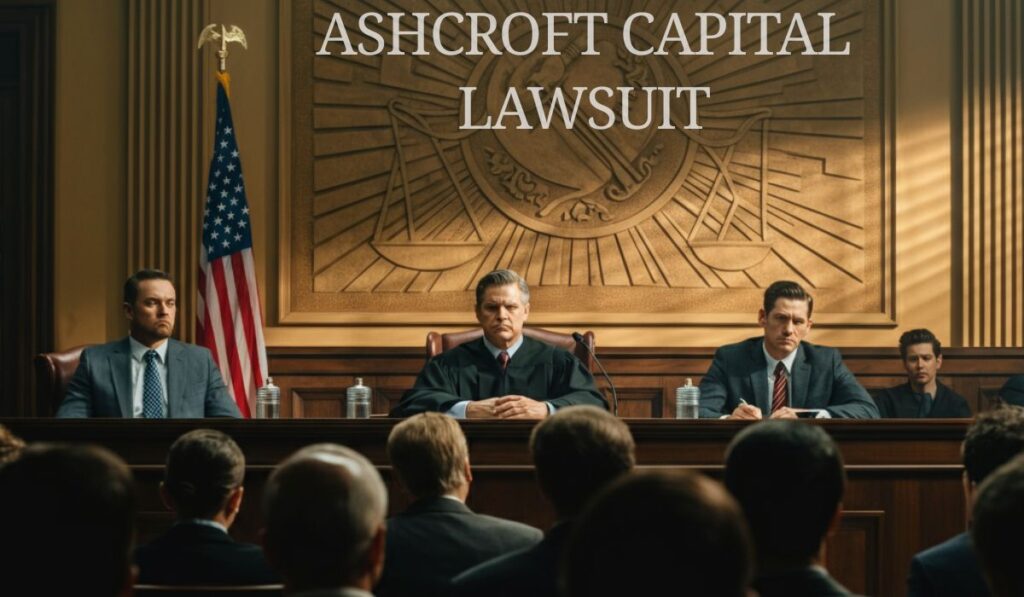Ashcroft Capital, once known as a rising star in the world of real estate syndication, now finds itself at the center of a legal controversy that could reshape investor trust across the private equity real estate sector. Filed in early 2025, the Ashcroft Capital lawsuit has sparked widespread concern among limited partners (LPs), analysts, and financial communities—particularly those who once viewed the firm as a reliable vehicle for stable passive income.
At the heart of this lawsuit are serious allegations of financial misrepresentation, lack of transparency, and breach of fiduciary duty. Plaintiffs claim they were misled about the projected returns of investment deals, resulting in unexpected losses and eroded confidence. With over $18 million in investor capital allegedly at stake and multiple court proceedings already underway, the outcome of this case could have far-reaching implications—not just for Ashcroft, but for the entire ecosystem of syndicators and real estate investors.
This homepage serves as your comprehensive hub for everything related to the lawsuit. From verified facts and legal filings to investor updates and payout possibilities, we’ll guide you through:
- A breakdown of the case’s key allegations
- A full lawsuit timeline with monthly updates
- Ashcroft Capital’s official responses
- Potential investor payout scenarios
- Lessons and red flags for current and future LPs
Whether you’re an investor with capital in Ashcroft funds, an industry professional tracking the case, or a concerned observer of the syndication space—this resource will keep you informed with clear, accurate, and unbiased coverage.
Let’s begin by understanding how this lawsuit started, who filed it, and what the legal claims are all about.
Case Summary & Lawsuit Overview

The Ashcroft Capital lawsuit was officially filed on February 12, 2025, under the case title Cautero v. Ashcroft Legacy Funds. The plaintiffs in this case include a group of 12 accredited investors, each of whom had invested substantial capital into various real estate syndication projects operated by Ashcroft Capital. Collectively, they allege over $18 million in damages stemming from what they claim were inflated return projections, misleading financial statements, and a breach of fiduciary responsibility.
Ashcroft Capital, a Texas-based firm known for acquiring and repositioning multifamily apartment complexes, had built its brand on the promise of high internal rates of return (IRR) and consistent passive income streams. However, according to the complaint, those returns were overstated by 4–6%, creating a significant gap between what was marketed and what investors actually received.
The lawsuit alleges several core legal violations:
- Misrepresentation of IRR and cash flow forecasts
- Failure to disclose material financial risks
- Delayed or inconsistent communication with limited partners (LPs)
- Continuing to charge sponsor fees even during periods of poor fund performance
- Alleged violation of SEC regulations regarding private placements
In their filings, the plaintiffs argue that Ashcroft Capital painted an overly optimistic financial picture in its investor presentations, emails, and offering memorandums. They claim that risks were either downplayed or completely omitted, leading them to make high-stakes investment decisions based on incomplete or misleading data.
This is not just a contractual dispute. The lawsuit potentially falls under federal securities law violations, meaning regulatory bodies such as the Securities and Exchange Commission (SEC) may also become involved depending on how the case develops.
At this stage, the legal proceedings are in the discovery phase, with both parties gathering documentation, financial records, and witness testimony. Early motions have been filed by Ashcroft Capital’s legal team seeking partial dismissal, while the plaintiffs continue to push for broader access to internal records and historical financial data from Ashcroft-managed properties.
This case is being closely watched by real estate professionals and limited partners across the country. If the allegations are proven in court, it could set a powerful legal precedent impacting how syndication deals are marketed, disclosed, and regulated.
In the next section, we’ll examine the specific allegations in greater detail—including the financial gaps, communication breakdowns, and investor concerns that led to this high-profile legal dispute.
Allegations Against Ashcroft Capital

At the core of the Ashcroft Capital lawsuit are a series of serious allegations that strike at the heart of investor trust, regulatory compliance, and transparency within real estate syndications. Filed by 12 accredited investors, the complaint paints a troubling picture of how Ashcroft Capital allegedly misled its limited partners (LPs) regarding financial performance, risk disclosures, and internal accountability.
1. Misrepresentation of IRR Projections
One of the most alarming claims centers on the inflation of Internal Rate of Return (IRR) projections. Investors allege that Ashcroft Capital overstated expected IRRs by 4% to 6% during initial presentations and marketing materials, including:
- Private Placement Memorandums (PPMs)
- Webinars and investment pitch decks
- Direct emails and verbal communications from investor relations teams
These projections were not supported by property performance or market fundamentals, according to the plaintiffs. In some cases, deals that were forecasted to produce double-digit annual returns instead delivered negative or breakeven cash flows, severely undermining trust and expected yields.
2. Incomplete Financial Disclosures
The lawsuit further accuses Ashcroft Capital of failing to disclose key financial risks tied to specific deals and fund-level obligations. This includes:
- Lack of transparency around capital reserves and loan structures
- Not informing LPs of balloon payments or variable-rate loan exposure
- Hiding delays in renovations and lease-up performance
- Failing to provide third-party audited financials in a timely manner
These omissions left investors in the dark and made it nearly impossible to assess true deal health until after distributions declined or capital calls were issued.
3. Delayed or Inconsistent Investor Communication
Plaintiffs also highlight a troubling pattern of poor communication:
- Quarterly updates were either delayed, vague, or overly positive despite deteriorating fundamentals
- Requests for detailed financial breakdowns or rent roll data were allegedly ignored
- Investors claim they were only notified about poor performance after capital had already been lost
This breakdown in communication is a potential breach of fiduciary duty, especially within private equity structures where investors are highly dependent on sponsor honesty.
4. Sponsor Fees Charged Despite Underperformance
According to the lawsuit, Ashcroft Capital continued to charge asset management and sponsor fees even during quarters where:
- Properties failed to meet operational benchmarks
- Cash distributions were paused or significantly reduced
- The overall fund underperformed
Plaintiffs argue this model disproportionately benefited the general partners (GPs), even as limited partners suffered losses — calling into question the ethical alignment between sponsor and investor interests.
5. Potential Securities Law Violations
Beyond contractual or fiduciary claims, the allegations may also extend into federal securities territory. If proven, this could trigger involvement from:
- The Securities and Exchange Commission (SEC)
- State-level financial regulators
- Potential class-action litigation from additional investors
The use of aggressive marketing language, combined with alleged omissions of risk, may violate Rule 10b-5 of the Securities Exchange Act, which prohibits fraudulent statements in connection with the sale of securities.
Why These Allegations Matter
This case isn’t just about one firm or one group of investors — it represents a broader issue in the real estate syndication space: how deals are marketed vs. how they actually perform. If Ashcroft is found liable for these claims, it could change:
- How IRRs are projected and audited in PPMs
- What types of disclosures must be included in investor memos
- How GPs and LPs share risk and responsibility in underperforming funds
As the case continues through the discovery phase, more documentation, internal communications, and financial reports will likely emerge — shedding further light on how these allegations came to be.
In the next section, we’ll walk through a timeline of key events — from the initial filing in February 2025 to the most recent court proceedings — so you can track this case every step of the way.
Timeline of Events
Understanding the Ashcroft Capital lawsuit requires following its progression from the first signs of investor dissatisfaction to the formal court filings and current legal proceedings. Below is a month-by-month timeline of the lawsuit, which we will continue to update as new developments unfold.
This section helps investors, stakeholders, and industry observers track the lawsuit’s momentum and stay informed about its most critical legal milestones.
January 2025 – Investor Frustration Peaks
- Multiple LPs begin raising concerns privately after quarterly distributions fall short of projections.
- Investor chat forums (including Wall Street Oasis and Reddit) see anonymous discussions about poor performance, opaque reporting, and suspected mismanagement.
- Several investors report difficulty obtaining accurate financial statements from Ashcroft’s investor relations team.
February 12, 2025 – Lawsuit Officially Filed
- A group of 12 accredited investors files a lawsuit in federal court under the case name Cautero v. Ashcroft Legacy Funds.
- The lawsuit seeks damages of $18 million, alleging misrepresentation of IRR, financial non-disclosure, and fiduciary breaches.
- Public attention increases as documents show alleged 4–6% overstatements in return projections.
March 2025 – Media Coverage & Response
- Syndication-focused outlets like Coruzant and IT Shifting publish initial reports on the lawsuit.
- Ashcroft Capital releases its first public statement denying all allegations, calling the claims “inaccurate and misleading.”
- CEO Joe Fairless reaffirms Ashcroft’s commitment to ethical investing in an internal email to LPs.
April 2025 – Pretrial Discovery Begins
- Court grants initial motions to begin discovery.
- Plaintiffs request internal financial documents, emails related to IRR modeling, and communication logs with LPs.
- Ashcroft’s legal team files a motion to dismiss parts of the complaint related to securities violations.
May 2025 – Legal Tension Increases
- Plaintiffs’ legal team accuses Ashcroft of withholding certain financial disclosures from investors pre-funding.
- A key former employee of Ashcroft (name not publicly released) submits a sworn affidavit supporting the plaintiffs’ claims regarding IRR manipulation and performance forecasting practices.
June 2025 – Investor Community Reaction Grows
- More LPs from Ashcroft’s past funds voice concerns on BiggerPockets and WSO forums.
- Reddit discussions highlight fears of a class action forming.
- Ashcroft adds a new legal counsel firm to handle growing complexity of the case.
July 2025 – Scheduled Hearing & Industry Buzz
- First court hearing scheduled to review motions and discuss timeline for additional depositions.
- Legal analysts speculate whether a settlement might be quietly negotiated before public testimony begins.
- Real estate investing blogs highlight the potential long-term regulatory implications of this case on syndicator disclosures.
Upcoming Milestones to Watch
| Date | Expected Event |
| August 2025 | Further depositions and document reviews in discovery phase |
| Q4 2025 | Possible mediation or settlement discussions |
| 2026 | Case may go to trial if no resolution is reached |
Why This Timeline Matters
Each legal milestone helps investors understand the progression, seriousness, and credibility of the case. Unlike rumors or isolated complaints, this documented sequence of events shows that this is a high-stakes lawsuit with federal-level implications, real plaintiffs, and potentially industry-shifting consequences.
We’ll continue updating this timeline as the lawsuit develops. Bookmark this page or check back monthly for new entries.
Coming up next, we’ll explore how Ashcroft Capital has officially responded to these allegations — including press statements, investor communications, and legal motions.
Ashcroft Capital’s Response

As scrutiny around the Ashcroft Capital lawsuit intensified, the firm moved swiftly to address the growing concerns from investors, media, and the broader real estate syndication industry. Publicly and privately, Ashcroft has maintained a firm stance of denying all allegations brought forward in the case Cautero v. Ashcroft Legacy Funds, asserting that the lawsuit is without merit and that the company has consistently operated with transparency and integrity.
1. Public Statements & Denials
Shortly after the lawsuit became public in March 2025, Ashcroft Capital issued an official press release stating:
“Ashcroft Capital strongly denies the allegations made in the lawsuit filed against our firm. We remain committed to transparency, ethical investing, and delivering long-term value to our investors.”
This statement was echoed by CEO Joe Fairless, who wrote directly to limited partners (LPs) via email, emphasizing the firm’s track record, the quality of its real estate acquisitions, and its dedication to communication. In his message, he stated:
“We understand that lawsuits attract attention, but we are confident that when the facts are reviewed, Ashcroft will be fully vindicated. We take our fiduciary responsibilities seriously and believe our track record reflects that.”
These initial responses were designed to reinforce confidence among both current and prospective investors, as concerns began circulating on forums and private investor networks.
2. Legal Defense Strategy
Ashcroft Capital retained two separate legal teams to manage the litigation — one focused on corporate defense, and the other specializing in securities compliance. In April 2025, their attorneys filed a motion to partially dismiss certain components of the lawsuit, specifically the federal securities violation claims.
Their legal argument included:
- The plaintiffs had access to offering documents with clearly defined risk disclosures.
- Performance fluctuations were due to market volatility, not misrepresentation.
- IRR projections were labeled as “estimates” and not guarantees of returns.
- All communications fell within industry norms for real estate syndication deals.
Ashcroft’s counsel positioned the lawsuit as an attempt by a few dissatisfied investors to reinterpret business risk as fraud — a framing intended to undercut the emotional and reputational impact of the allegations.
3. Communication With Investors
Privately, Ashcroft Capital increased outreach to its investor base. According to reports from LPs, the company has:
- Held quarterly webinars to address fund performance and answer legal-related questions
- Provided limited legal commentary while reiterating a commitment to transparency
- Shared summarized fund performance data showing portfolio occupancy rates, rent growth, and debt service metrics to counter concerns
While many investors appreciated the proactive communication, others have expressed frustration that certain financials or project-level updates remain vague, especially for underperforming assets within Ashcroft’s Legacy Funds.
4. Operational Adjustments
To demonstrate responsiveness and credibility during the legal process, Ashcroft has reportedly made several operational changes, including:
- Hiring a third-party accounting firm to review investor reporting practices
- Enhancing quarterly reporting templates to include IRR-to-date vs. IRR-at-acquisition
- Improving internal LP support ticket systems and turnaround times for documentation requests
- Reassessing future deal presentation standards, particularly in new fund launches
These steps, while not explicitly tied to the lawsuit in public statements, signal a shift toward damage control and reputational risk management.
5. Industry and Media Reaction
Industry analysts remain split on Ashcroft’s position:
- Supporters argue that the company’s willingness to communicate, provide data, and improve practices speaks to its legitimacy.
- Critics, however, suggest that the lawsuit has already exposed systemic issues in the syndication model — and Ashcroft’s defensive posture may not be enough to repair trust if core allegations prove accurate.
Meanwhile, media outlets such as Coruzant, Cordless.io, and Management Works Media continue to monitor Ashcroft’s responses and legal filings closely, publishing analysis and investor guidance based on both plaintiff claims and company statements.
Summary
Ashcroft Capital has remained firm in its denial of all wrongdoing and continues to fight the lawsuit through legal channels. Simultaneously, it has worked to reassure stakeholders through public statements, improved investor communications, and internal transparency reforms.
However, the ultimate outcome of the lawsuit — and the court’s interpretation of Ashcroft’s projections, disclosures, and investor treatment — will play a decisive role in shaping the firm’s reputation going forward.
Next, we’ll take a deeper look at the investor sentiment surrounding the lawsuit — including forum reactions, limited partner concerns, and the broader community response across the real estate syndication space.
Investor Reactions & Community Sentiment

Beyond the courtroom, the Ashcroft Capital lawsuit has triggered a wave of concern, debate, and speculation across the real estate investing community. From private Facebook groups and investor Slack channels to public forums like Wall Street Oasis, Reddit, and BiggerPockets, current and past limited partners (LPs) are voicing serious questions about Ashcroft’s practices, fund performance, and overall transparency.
This section highlights real reactions from the community — showcasing how the lawsuit is being perceived by investors, industry experts, and everyday observers navigating the syndication space.
1. Concerns Over Transparency and Communication
Many investors report feeling blindsided by the lawsuit — not necessarily because of the allegations themselves, but because of how little warning they received beforehand. Posts on BiggerPockets and private LP communities show users asking questions like:
“Why didn’t Ashcroft disclose these problems earlier?”
“I never saw a capital call coming, and then suddenly distributions stopped.”
“Is anyone else still waiting on fund performance reports from Q4 2024?”
Some LPs say they were satisfied with Ashcroft’s early communication, but by 2023 and 2024, updates grew inconsistent and lacked project-level detail — particularly for underperforming assets. Others shared that emails requesting clarification about IRR shortfalls or renovation delays went unanswered.
2. Frustration Around Capital Calls and Paused Distributions
In various forum threads, former and current investors discuss capital calls being issued even as cash flow distributions dried up:
“They asked for more capital after underperforming for four quarters straight.”
“Ashcroft kept charging asset management fees while we got nothing.”
These accounts directly mirror the core allegations of the lawsuit, where plaintiffs argue that general partners prioritized fee collection over fiduciary responsibility.
Investors across platforms are now asking whether Ashcroft’s compensation structure was truly aligned with fund performance, or if incentives were weighted too heavily toward upfront profits for the sponsor.
3. Forum Activity & Community Discussions
Here’s a snapshot of actual discussions happening across key platforms:
Wall Street Oasis (WSO)
A popular thread titled “Another One Bites the Dust — Ashcroft Capital” includes a range of investor sentiments:
- Top-voted comment:
“Class A investors need to sue and either force a sale or lock up remaining capital to salvage anything left.” - Other users express fear that this lawsuit will trigger similar actions against other sponsors.
Reddit – r/realestateinvesting
On Reddit, users debate whether this marks the beginning of a broader crackdown on aggressive IRR marketing. One post reads:
“Syndicators have been overpromising for years. Ashcroft just got caught first.”
Some commenters defend Ashcroft, noting that market headwinds and rising interest rates contributed to shortfalls. Others say that’s no excuse for under-delivering on investor expectations or failing to communicate proactively.
BiggerPockets
Investors on BiggerPockets are divided. Some long-time syndication participants express cautious optimism:
“Ashcroft still has solid properties and can recover if they clean house.”
Others argue that the brand is irreparably damaged, and future fundraising may be severely limited regardless of the lawsuit’s outcome.
4. Impact on Ashcroft’s Reputation & Fundraising Future
Even before the lawsuit’s verdict, the reputational damage appears to be significant. Syndication relies heavily on investor trust — and even a perception of impropriety can derail fundraising.
- Prospective LPs are already citing the lawsuit as a reason to pause investment in new Ashcroft offerings.
- Current investors are reportedly considering secondary sales of their stakes, even at a discount.
- Competing firms are highlighting the Ashcroft case in their own investor pitches — using it as an example of “what not to do.”
If trust in Ashcroft Capital continues to erode, the brand may need to pivot to new investor bases or rebrand entirely.
What This Means for Other LPs
Whether or not investors are directly involved in this lawsuit, the sentiment in the community is clear:
- LPs want full transparency — not marketing spin.
- They expect accurate IRR projections supported by third-party data.
- And when things go wrong, they want timely, honest communication — not silence or evasiveness.
This case may serve as a wake-up call not just for Ashcroft, but for all sponsors operating in the private equity real estate space.
In the next section, we’ll break down the most pressing topic for many investors: Will there be a payout? We’ll examine possible outcomes of the lawsuit and what each scenario might mean for recovery of investor funds.
Ashcroft Capital Lawsuit Payout Possibilities

One of the most urgent questions investors are asking is: Will there be a payout from the Ashcroft Capital lawsuit? With more than $18 million in alleged damages and 12 accredited investors leading the charge, the potential for financial recovery is a critical concern.
While no payout has been confirmed as of July 2025, several legal pathways exist — each with different implications for investors, Ashcroft Capital, and the future of real estate syndication.
1. Settlement Before Trial (Most Common Outcome)
In many cases like this, lawsuits of this nature resolve outside of court through a confidential settlement agreement.
Key Characteristics:
- No public admission of wrongdoing
- Ashcroft agrees to pay a negotiated sum
- Terms may include NDAs and investor gag clauses
- Investors may receive partial reimbursement (not full principal)
Implications:
- Settlement could restore some LP losses
- Allows Ashcroft to avoid public testimony and reputational escalation
- Limits future litigation if a class action is avoided
Likelihood: High — given the publicity and cost of prolonged litigation, settlement is a realistic scenario, especially before trial depositions escalate.
2. Plaintiffs Win in Court (Less Common, Bigger Payout Potential)
If the plaintiffs win at trial, the court could award:
- Compensatory damages (direct losses)
- Punitive damages (if misconduct is proven extreme)
- Court-ordered fee reimbursement
- Injunctions on future fundraising activity
Implications:
- LPs may recover a higher percentage of their investment losses
- Ashcroft could be barred from certain investment activities
- SEC or state regulators may take parallel enforcement actions
Likelihood: Medium — but depends on proving intent, misrepresentation, and breach of fiduciary duty beyond investor expectations.
3. Ashcroft Wins (Case Dismissed or Verdict Favorable)
If the court finds Ashcroft Capital did not breach fiduciary or legal duties, no payout would be required.
Ashcroft’s defense strategy argues that:
- IRRs were projections, not guarantees
- Risks were disclosed in offering documents
- Market downturns, not misconduct, caused underperformance
Implications:
- Plaintiffs may lose invested funds with no recovery
- Ashcroft’s operations resume, though reputational recovery may be slow
- LP trust may remain fractured despite legal victory
Likelihood: Low to Medium — investor sentiment and documentation will heavily influence the court’s view of “reasonable expectation.”
4. Class Action Formation (If More LPs Join In)
If additional investors come forward, the case could evolve into a class action. This opens the door for:
- Broader claims from other funds or investor groups
- A consolidated payout structure
- Publicity increases, intensifying pressure to settle
Implications:
- Settlement or trial award could grow substantially
- Ashcroft may be forced to restructure operations
- LPs not in the original 12 could benefit from group action recovery
Likelihood: Possible — investor chatter on Reddit and WSO suggests others may be watching closely, but class action has not been filed as of July 2025.
Estimated Timeline for Payout (If Any)
| Stage | Expected Timeframe |
| Discovery ends | Q3 2025 |
| Settlement window | Q3–Q4 2025 |
| Trial (if needed) | Early–Mid 2026 |
| Payout processing (if awarded) | Within 3–6 months after resolution |
Important Note: Even if a settlement occurs, payouts may take months depending on administrative processes, fund availability, and legal verification.
What Should Investors Do?
If you’re an investor in any Ashcroft Capital offering — particularly Legacy Funds or Class A/B shares — here’s what you should do now:
- Review your original offering documents and investor agreements
- Track lawsuit updates regularly (bookmark this page for monthly recaps)
- Consider consulting a securities attorney if you believe you’ve suffered financial harm
- Do not rely solely on rumors or forum posts — ensure your understanding comes from verified sources or legal experts
While no payout has been confirmed as of now, the structure and scale of this lawsuit suggest that some form of financial settlement or recovery is possible, especially if the case avoids trial. Investors should continue monitoring developments and evaluating their exposure as new filings and hearings are scheduled.
Next, we’ll look at the latest updates in July 2025, including legal developments, filings, and upcoming milestones.
Ashcroft Capital Lawsuit Updates – July 2025 (H2)

As of July 2025, the Ashcroft Capital lawsuit continues to progress through its early legal stages, with several significant updates emerging from both court filings and investor channels. This section provides the latest verified developments in the case Cautero v. Ashcroft Legacy Funds, giving investors and observers a clear, timely, and accurate view of what’s happening behind the scenes.
We’ll continue to update this section monthly with new events, rulings, public statements, and insider perspectives as they become available.
1. Discovery Process Deepens
In early July, both sides entered a critical phase of discovery. The court ordered Ashcroft Capital to produce internal documentation related to:
- IRR projections shared with LPs between 2021–2024
- Marketing materials, webinars, and investor email communications
- Property-level financials for underperforming multifamily assets
- Fee and compensation records for the General Partner (GP)
Ashcroft’s legal team submitted a partial production on July 10 but requested extended time to compile complete records. Plaintiffs argue this delay may be an attempt to withhold or slow down the process. A hearing on this motion is scheduled for August 5, 2025.
2. Former Ashcroft Employee to Testify
A new affidavit surfaced from a former Ashcroft acquisitions analyst, who worked at the firm between 2022–2023. In the sworn statement, the ex-employee claims:
“There was internal pressure to show deals as more profitable than they were… IRR figures were often adjusted in marketing decks to match competitive benchmarks, not project fundamentals.”
This testimony may become a central piece of the plaintiffs’ case and has raised alarm in industry circles. Ashcroft has not publicly responded to the affidavit, though internal sources report a legal rebuttal is in the works.
3. Settlement Negotiations Quietly Underway?
Multiple investor forums (including BiggerPockets and Reddit) have speculated that informal settlement discussions began in late June — though this has not been confirmed in court.
What we know:
- Ashcroft recently retained a second legal team specializing in class action mediation.
- The court has scheduled a mediation pre-conference for September 12, 2025, which is typically a sign that at least one party is open to a settlement discussion.
If true, this could indicate a behind-the-scenes effort to resolve the case before full public hearings begin in late 2025.
4. Media Coverage Expands
Coverage of the lawsuit expanded in July, with multiple outlets publishing updates and legal interpretations:
- Cordless.io released an article titled “Syndication Reckoning: What the Ashcroft Case Means for Private LPs”, highlighting the growing push for disclosure reform in passive real estate investing.
- Coruzant.com published a July 15 investor Q&A focused on actionable steps LPs can take if they’re involved in a fund under legal scrutiny.
- Syndicator-focused podcasts have begun discussing the case as a potential “Theranos Moment” for real estate investing.
These signals suggest the lawsuit is no longer just an internal investor issue — it’s now being used as a case study in compliance, ethics, and fund structure transparency.
5. Key Legal Dates Ahead (H3)
| Date | Event |
| August 5, 2025 | Discovery deadline compliance hearing |
| September 12, 2025 | Mediation pre-conference (tentative) |
| October 2025 | Depositions begin for GP leadership and fund managers |
| Q1 2026 | Trial window opens (if no settlement reached) |
Community Reaction to July Updates
Investor sentiment remains cautious but active:
“That affidavit changes everything. I was 50/50 on whether to hold my Ashcroft stake. Now I’m watching every update.” — Reddit user
“They may settle just to prevent more internal docs from leaking. The timeline looks longer than expected though.” — Wall Street Oasis forum member
Across platforms, LPs are advising each other to stay patient but organized, and to begin gathering their own documents and capital call histories in case broader legal action (such as a class action) emerges.
Summary: July 2025 Status Snapshot
- Discovery is underway, with tension around compliance deadlines
- New insider testimony adds weight to the plaintiffs’ claims
- Settlement talks may be in motion, based on court activity and legal shifts
- Key dates set through Q4 2025, with trial on the horizon in 2026
- Investor awareness and media pressure are building rapidly
In the next section, we’ll zoom out to explore the larger impact this lawsuit may have on the real estate investment industry — including how syndicators, LPs, and fund structures may evolve in response to what’s shaping up to be one of the most watched investment lawsuits in recent years.
Impact on the Real Estate Investment Industry
The ripple effects of the Ashcroft Capital lawsuit extend well beyond a single firm or group of investors. This case is quickly becoming a referendum on real estate syndication, raising serious questions about transparency, investor protection, and regulatory oversight within one of the fastest-growing investment sectors.
As the lawsuit unfolds, it’s already shifting how limited partners (LPs) evaluate deals, how sponsors structure and market offerings, and how regulators may step in to enforce stricter compliance across private real estate investing.
1. Investor Trust in Real Estate Syndication Is Being Tested
Real estate syndication, especially in the multifamily space, has exploded over the last decade. It gave everyday accredited investors access to institutional-grade deals through pooled structures, often led by charismatic operators like Ashcroft Capital.
But trust is the foundation of these deals — and the Ashcroft lawsuit has cracked that foundation.
Key Investor Concerns Now Include:
- Are IRR projections rooted in reality or marketing hype?
- Are fund managers overcharging fees during underperformance?
- Will sponsors provide full risk disclosure — or only highlight upside?
LPs across online forums, investor webinars, and private Slack groups are now reassessing their current holdings and future allocations. Many have paused new investments, waiting for regulatory clarity or proof of stronger investor protections.
2. Calls for More Regulation in Private Offerings
Unlike publicly traded REITs, real estate syndications operate under Reg D exemptions, which require less disclosure. The Ashcroft Capital lawsuit has exposed how that gap can be exploited — or at the very least, how it leaves investors vulnerable to underperformance without recourse.
This case could accelerate:
- SEC scrutiny on how private sponsors market IRRs
- State-level enforcement of fiduciary obligations in Reg D deals
- Mandatory use of third-party audited financials for investor reports
- More lawsuits from LPs against underperforming sponsors
The broader industry is now anticipating new guidelines from regulatory bodies, especially if this lawsuit ends in a loss or high-profile settlement.
3. Fundraising & Deal Flow May Slow
Sponsors across the U.S. are already reporting:
- Slower investor onboarding
- Higher demand for transparency in underwriting
- LPs requesting customized legal clauses to protect capital
- Pushback on traditional fee structures (e.g., 2% AUM + promote splits)
The Ashcroft Capital brand, once viewed as a syndication success story, is now a case study in what happens when trust erodes — even before a verdict is issued.
This chilling effect is spreading to other mid-size operators who modeled their growth on similar strategies: fast acquisitions, renovation-based value-adds, and high leverage.
4. Shift Toward Institutional-Style Oversight
Many industry observers believe the Ashcroft lawsuit will usher in a new era of professionalization in syndication.
Expected shifts may include:
- LPs demanding board representation or voting rights
- Sponsors adopting quarterly audit requirements
- Deal decks being reviewed by compliance consultants before release
- Use of more conservative debt structures to mitigate overleveraged portfolios
Private equity real estate is maturing — and this case may be the tipping point where “mom-and-pop” sponsors lose favor to institutional-quality operators who adopt best practices proactively.
5. Impact on Related Sectors: REITs & Crowdfunding Platforms
While Ashcroft Capital is not a REIT, the fear triggered by the lawsuit has extended into adjacent asset classes. Investors now want assurance that:
- Their REITs are backed by audited, stable underlying assets
- Crowdfunded deals aren’t managed by underqualified operators
- All platforms perform due diligence on sponsors and fee disclosures
Major crowdfunding platforms like Fundrise, RealtyMogul, and CrowdStreet have begun updating their sponsor vetting language in response to the increased scrutiny.
In short: the Ashcroft case is raising the bar across all real estate investment models.
What This Means Going Forward
| Group | Impact |
| LP Investors | More cautious, demanding transparency & due diligence |
| Sponsors/Syndicators | Facing pressure to professionalize, disclose more, and justify fees |
| Regulators | Likely to revisit Reg D exemption frameworks |
| Platforms & Aggregators | Updating sponsor screening and investor protection mechanisms |
The Ashcroft Capital lawsuit is more than just a legal case — it’s a warning shot across the entire passive investing industry. Regardless of how the court rules, it has already begun shaping a more cautious, compliance-driven, and investor-centric future for real estate finance.
In the next section, we’ll distill the key lessons learned from this case — so investors and sponsors alike can navigate future opportunities with better protection and insight.
What Investors Can Learn from This Case

Whether you’re a seasoned limited partner or just beginning to explore real estate syndication, the Ashcroft Capital lawsuit offers a wake-up call for all private market investors. It highlights vulnerabilities in the current investment ecosystem — and provides critical insights on how to make safer, smarter financial decisions moving forward.
This section breaks down the key lessons learned so that you can protect your capital, avoid red flags, and demand more transparency in every deal you join.
1. Projections Are Not Promises
One of the core issues in the Ashcroft Capital lawsuit revolves around inflated IRR projections — estimated returns that allegedly didn’t match reality.
What to Learn:
- Always treat IRR projections as best-case scenarios, not guaranteed outcomes.
- Ask for conservative underwriting versions that show “downside” and “base case” returns.
- Be wary if a sponsor only shows double-digit IRRs without explaining the risk behind them.
Tip: If a deal shows 17–20% projected IRR, ask: “What happens if rents don’t grow as expected?”
2. Read the PPM — And Then Ask Questions
Private Placement Memorandums (PPMs) are legal documents that detail investment risks. In many cases, they contain disclosures that can limit your ability to sue if losses occur.
What to Learn:
- Always review the PPM thoroughly before wiring funds.
- Focus on sections about fees, risk disclosures, waterfall structures, and exit scenarios.
- If something is unclear, ask the sponsor directly in writing — and save the reply.
Tip: If you’re not confident reading legal docs, hire a securities attorney to review it for you.
3. Fee Structures Matter More Than You Think
In the Ashcroft case, investors allege that the company continued to collect fees even during underperformance. Many LPs miss this in their review process.
What to Learn:
- Ask: “Are sponsor fees performance-based or fixed?”
- Understand if fees are charged even when distributions stop.
- Avoid deals where sponsors profit while LPs lose money — it’s a red flag.
Tip: Look for sponsors who co-invest substantial capital in the deal (aka “skin in the game”).
4. Vet the Sponsor’s Track Record & Ethics
A flashy website or YouTube presence isn’t enough. Ashcroft Capital had a polished brand — but that didn’t stop internal financial and legal breakdowns.
What to Learn:
- Ask for full performance records of past deals — not just cherry-picked winners.
- Research forum feedback, Reddit reviews, and BiggerPockets threads about the sponsor.
- Pay attention to how sponsors handle downturns — that’s where character shows.
Tip: A sponsor who answers tough questions honestly is usually more reliable than one who avoids them.
5. Communication Is Everything
According to investors involved in the lawsuit, one of the biggest pain points wasn’t just financial — it was the lack of clear, timely communication from Ashcroft during underperformance.
What to Learn:
- Choose sponsors who offer monthly or quarterly updates with financials and rent rolls.
- Ask if you can access property-level data, not just fund-level summaries.
- Walk away from sponsors who ignore your questions or dodge transparency.
Tip: If communication is slow before you invest, it will only get worse afterward.
6. Diversify Across Sponsors, Not Just Properties
Many investors placed large allocations into Ashcroft Capital, trusting the brand rather than spreading their risk. When problems surfaced, they had limited fallback options.
What to Learn:
- Never place all your capital with one sponsor or fund.
- Diversify across multiple operators, markets, and property types.
- Maintain a cash reserve for emergencies — even in passive investments.
Tip: Don’t chase the highest return. Protect your capital first — then grow it.
Summary: Be a Smarter, Safer Investor
| Lesson | Action |
| Don’t trust projections blindly | Ask for conservative case scenarios |
| Know the documents | Read the PPM and ask legal questions |
| Understand fees | Align performance with compensation |
| Vet the operator | Past performance, public sentiment, ethics |
| Prioritize transparency | Regular updates and full disclosures |
| Diversify wisely | Spread risk across sponsors and deal types |
The Ashcroft Capital lawsuit has become a case study in what happens when investor expectations, marketing claims, and performance don’t align. Whether you’re currently invested or simply learning from a distance, these lessons can help you make better decisions, ask sharper questions, and protect your portfolio against unseen risks.
Next, we’ll answer the most frequently asked questions (FAQs) about the lawsuit — including who filed it, whether there will be a payout, and what’s likely to happen next.
FAQs – Ashcroft Capital Lawsuit
What is the Ashcroft Capital lawsuit about?
The case, Cautero v. Ashcroft Legacy Funds, was filed on February 12, 2025, by 12 accredited investors. It alleges over $18 million in damages due to alleged misrepresentation of IRR projections (4–6% higher than actual), insufficient financial disclosure, undue fees, and breach of fiduciary duty.
Who filed the lawsuit and why?
The lawsuit was initiated by a group of 12 accredited investors who invested in Ashcroft’s multifamily syndication deals. They claim they were misled by inflated return projections, poor risk disclosures, and lapses in communication—resulting in unexpected losses and trust erosion.
Is there a payout for investors?
No payout has been confirmed as of July 2025. Potential outcomes include a confidential settlement, a court-ordered payout if plaintiffs win at trial, or no payout if Ashcroft prevails. Discovery and depositions suggest that a settlement remains the most likely scenario.
What is the current status or update of the lawsuit?
As of July 2025, the case is in the discovery phase. Ashcroft has produced partial financial and communications records, while plaintiffs await further disclosures. A hearing to address discovery delays is scheduled for August 5, 2025, with mediation planned in September 2025.
Could this lawsuit impact future Ashcroft syndications?
Absolutely. Even without a verdict, the lawsuit has led to:
Hesitation among prospective LPs
Increased due diligence requests
Pressure on Ashcroft to improve transparency
Possible regulatory scrutiny that could affect the firm’s fundraising and deal processes
Will this lawsuit affect REITs or the broader real estate market?
Yes, to a degree. While Ashcroft is not a REIT, the case has raised investor awareness about transparency and fee structures in all real estate deals. It may prompt stricter disclosure standards for both syndicators and REIT operators.
How long will the lawsuit take to resolve?
The timeline depends on several factors:
Discovery completion: expected Q3 2025
Settlement or trial: likely Q4 2025–Q1 2026
Payouts: if any, would follow 3–6 months post-resolution
What should current and potential investors do now?
Review your PPMs and investment agreements
Monitor case updates carefully (bookmark this page)
Request full financial and fund-level data from Ashcroft
Consult with a securities or real estate attorney if you believe you’ve suffered losses
Could this lawsuit turn into a class action?
Possibly. If more investors with similar experiences join, the case could be converted into a class action. This would expand eligibility for payouts, raise settlement stakes, and increase reputational exposure for Ashcroft.
How reliable is the information here?
This page is regularly updated based on court filings, verified investor disclosures, media coverage, and community feedback. Check the “Ashcroft Capital Lawsuit Updates” section above for the most recent developments.
Conclusion
The Ashcroft Capital lawsuit isn’t just a legal matter — it’s a powerful signal to investors, syndicators, and the entire real estate investment community. Whether you’re currently invested in an Ashcroft fund, considering syndication opportunities elsewhere, or simply watching this story unfold, one truth is clear:
Transparency, communication, and due diligence are no longer optional — they are essential.
As we’ve explored in this guide, the lawsuit has uncovered critical lessons about:
- How projections are marketed vs. what’s delivered
- The importance of reading and understanding investment documents
- Why investor trust must be earned — and maintained
From the original filing to emerging updates, insider testimony, payout possibilities, and community sentiment, this homepage will continue to serve as your go-to resource for tracking the Ashcroft Capital lawsuit in real time.